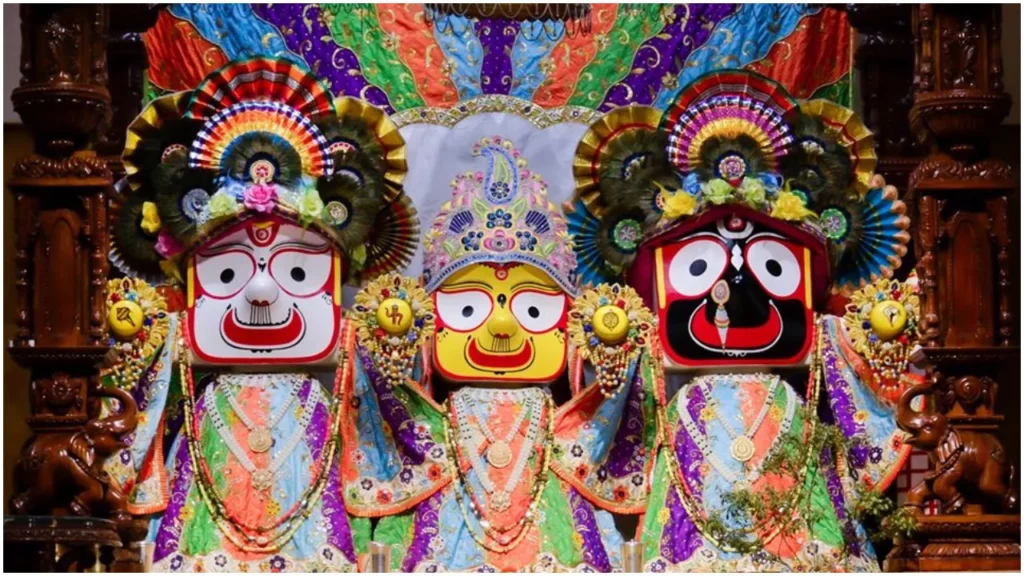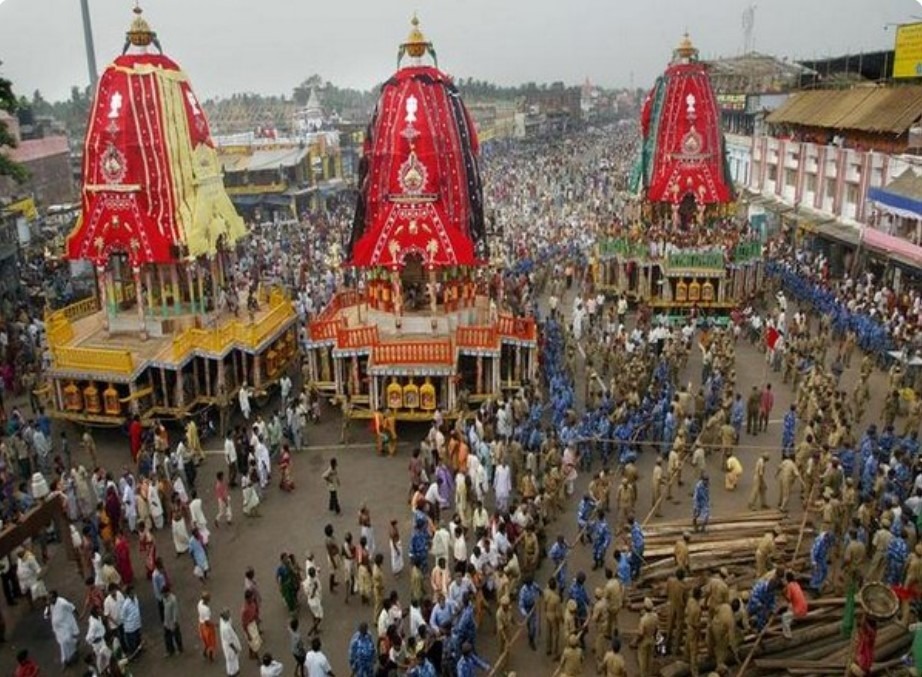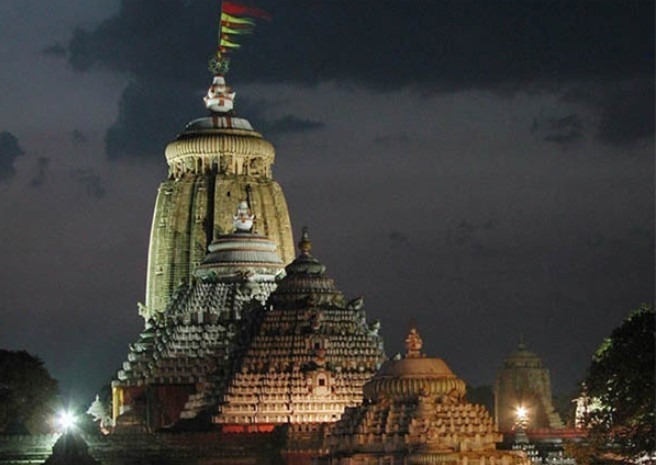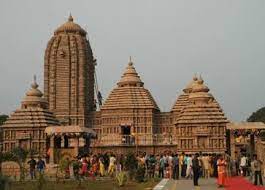
Jagannath Temple
Jagannath Temple, situated in the sacred city of Puri, Odisha, stands as a revered Hindu pilgrimage site and a testament to religious and cultural vibrancy. Dedicated to Lord Jagannath, a form of Lord Krishna, the temple is renowned for its annual Rath Yatra, a grand chariot procession attracting millions of devotees. Believed to have been built in the 12th century by King Anantavarman Chodaganga Deva, the temple’s architecture reflects the Kalinga style and houses the deities Lord Jagannath, his brother Balabhadra, and sister Subhadra. Beyond its spiritual significance, the temple is a hub of cultural traditions, hosting various rituals, festivals, and classical performances, making it a focal point of devotion, heritage, and vibrant spirituality in the heart of Puri.
Historical background and Architectural splendor
This Temple holds a rich historical legacy, dating back to the 12th century when it was commissioned by King Anantavarman Chodaganga Deva. The temple’s construction, completed in the 12th century, signifies not only a place of worship but a cultural and architectural marvel that has withstood the tests of time. Over the centuries, it has undergone renovations and enhancements, becoming a symbol of Odisha’s architectural prowess.
The temple’s architectural splendor follows the Kalinga style, characterized by a towering spire (shikhara) and intricate carvings that adorn its exterior. The main shrine, known as the ‘Deul,’ houses the deities Lord Jagannath, Balabhadra, and Subhadra. The structure stands as a majestic representation of Odishan temple architecture, with its pyramidal spire dominating the skyline. The temple complex includes various halls, pavilions, and beautifully sculpted pillars, showcasing the artistic finesse of ancient craftsmen.
The historical background and architectural grandeur of Jagannath Temple not only draw pilgrims seeking divine blessings but also captivate enthusiasts of art and history, making it a revered landmark that seamlessly intertwines spirituality with cultural and architectural brilliance.

Religious Significance
Jagannath Temple in Puri holds profound religious significance in Hinduism, particularly within the Vaishnavism tradition. Dedicated to Lord Jagannath, considered a form of Lord Krishna, the temple is a sacred pilgrimage site that attracts millions of devotees seeking divine blessings and spiritual solace. The temple's sanctity is deeply rooted in mythology and tradition, with legends surrounding the installation of the deities—Lord Jagannath, Balabhadra, and Subhadra. The annual Rath Yatra, or chariot festival, is a major highlight, symbolizing the journey of the deities from the temple to the Gundicha Temple. This grand procession draws devotees from far and wide, exemplifying the significance of Lord Jagannath in the hearts of the faithful. The temple complex is not merely a physical structure but a spiritual abode where rituals, prayers, and festivals are conducted with fervor. The unique aspect of the deities' wooden forms, changed in a specific ritual known as 'Nabakalebara,' further enhances the religious importance of Jagannath Temple. For devotees, a visit to Jagannath Temple is a sacred pilgrimage, offering an opportunity for spiritual elevation, devotion, and a connection with the divine presence of Lord Jagannath, making it a pivotal center of religious fervor and cultural heritage in the heart of Odisha.


Festival and Celebrations
Here the festivals celebrated are Rath Yatra, Snana Yatra, Nabakalebara, Chandan Yatra, Chandan Yatra, Niladri Bije and Suna Besha.
Surroundings area & attractions
- Chilika Lake: A short drive from Puri, Chilika Lake, Asia's largest brackish water lagoon, is a haven for birdwatchers and nature enthusiasts, renowned for its biodiversity.
- Konark Sun Temple: A UNESCO World Heritage Site, the Konark Sun Temple, known for its intricate architecture, is located about 35 kilometers from Puri, offering a fascinating historical excursion.
- Puri Beach: Apart from the religious significance, Puri Beach is a vibrant spot for leisure, water activities, and enjoying the coastal ambiance.
FAQ
The Jagannath Temple is a famous Hindu temple dedicated to Lord Jagannath, a form of Lord Vishnu, located in Puri, Odisha, India. It is one of the Char Dham pilgrimage sites for Hindus.
Lord Jagannath is considered a form of Lord Vishnu, along with his siblings Balabhadra (Balarama) and Subhadra. They are worshiped together in the Jagannath Temple.
The exact date of the temple’s construction is uncertain, but it is believed to have been built in the 12th century by King Anantavarman Chodaganga Deva of the Eastern Ganga dynasty
The Rath Yatra, also known as the Chariot Festival, is an annual festival celebrated in Puri, during which the deities of the Jagannath Temple—Lord Jagannath, Balabhadra, and Subhadra—are taken out of the temple in grand processions and placed on chariots, which are pulled by devotees. It is one of the most significant religious events in India.
No, the Jagannath Temple has strict entry restrictions, and non-Hindus are not allowed to enter the main sanctum sanctorum of the temple. However, they can visit the outer precincts and observe the temple from outside.
The Jagannath Temple is known for its elaborate daily rituals, including various offerings, prayers, and ceremonies performed by temple priests. Some of the major rituals include Mangal Aarti, Madhyanha Dhupa, Sandhya Aarti, and Badasinghara Besha.
The temple features the Kalinga architectural style, characterized by its pyramid-shaped tower (called Vimana), numerous spires, and intricate carvings depicting various mythological themes. The temple complex covers a large area and includes several smaller shrines and structures.
Yes, visitors are required to adhere to certain rules and dress codes when visiting the Jagannath Temple. These may include wearing modest attire, removing shoes before entering the temple premises, and maintaining silence and decorum within the temple complex.
Yes, tourists are allowed to visit the Jagannath Temple and explore its outer precincts. However, they must respect the religious sentiments of the devotees and follow the rules and regulations set by the temple authorities.
Photography is generally not allowed inside the Jagannath Temple, particularly in the inner sanctum where the deities are housed. However, visitors may be allowed to take photographs in designated areas outside the temple complex. It’s best to check with the temple authorities for specific guidelines.
The flag atop the spire of the Jagannath Temple, known as the Patita Pavana (Savior of the Fallen), is an important symbol. It is changed every day before sunrise and is considered auspicious. Devotees believe that seeing the flag brings blessings and removes obstacles.
The management of the Jagannath Temple is overseen by the Shree Jagannath Temple Administration (SJTA), which is a body constituted by the Government of Odisha. The administration is responsible for the day-to-day affairs, maintenance, and smooth functioning of the temple.
According to legend, the Jagannath Temple in Puri was originally built by King Indradyumna after he received divine instructions in a dream. The temple is believed to have been reconstructed and renovated several times over the centuries.
The Mahaprasad of the Jagannath Temple is considered highly sacred and is believed to carry the blessings of the deities. It is prepared in the temple kitchen, known as the Ananda Bazaar, and is offered to the deities before being distributed among devotees. It is believed that partaking in this food sanctifies the soul.
Yes, apart from the Rath Yatra, several other festivals are celebrated at the Jagannath Temple throughout the year, including Chandan Yatra, Snana Yatra, Nava Kalebara, a
The Nila Chakra is a large disc-shaped wheel mounted atop the temple’s spire. It is made of alloy and is one of the largest such wheels in India. The Nila Chakra is considered highly sacred and is believed to possess divine powers. It is worshipped by devotees during festivals.
Yes, there are several guest houses and dharmashalas (pilgrim rest houses) near the Jagannath Temple that provide accommodation to pilgrims and visitors. Additionally, there are numerous hotels and lodges available in Puri to suit different budgets and preferences.
Yes, devotees are allowed to offer prayers and perform rituals at the Jagannath Temple. However, certain guidelines and procedures need to be followed, and it’s advisable to seek assistance from temple priests or authorities for conducting any specific rituals.
Efforts have been made to make the Jagannath Temple accessible to people with disabilities. However, due to the historical architecture of the temple and certain restrictions, access to all areas may not be possible for individuals with mobility issues. It’s recommended to inquire about accessibility options beforehand.
The Jagannath Temple accepts donations from devotees and well-wishers for various purposes, including temple maintenance, festivals, and charitable activities. Donations can be made directly at the temple or through designated channels managed by the temple administration.
Visitor information
Entry Fee: No fee
Timings :
- 6am- 9pm
Darshan Days- All days
Address:
Grand Road, Puri, Odisha, India - 752001.
Notable Events and Incidents
- Rath Yatra:The annual Rath Yatra, or Chariot Festival, is one of the most famous events associated with the Jagannath Temple.
- Nabakalebara:The last Nabakalebara took place in 2015, a sacred ceremony associated with changing the wooden images of the deities in the temple.
Connectivity :
- By Air: The nearest airport is Biju Patnaik International Airport in Bhubaneswar, approximately 60 kilometers away. From the airport, taxis and buses are available to reach Puri.
- By Rail: Puri Railway Station is well-connected to major cities in India. The temple is within walking distance from the railway station.
- By Road: Puri has a well-developed road network, and buses, taxis, and auto-rickshaws are readily available for transportation within the city and from nearby towns.
